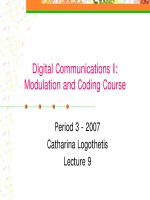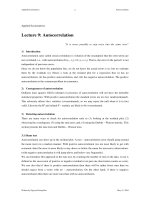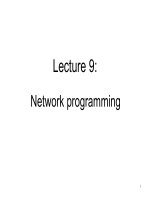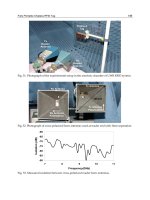2106 lecture 9 identification mineral
Bạn đang xem bản rút gọn của tài liệu. Xem và tải ngay bản đầy đủ của tài liệu tại đây (66.48 KB, 40 trang )
Lecture 9- 31 October 2013
No calculation questions on midterm
Non answered protein q
Non gi tract catabolism of proteins
Norepinephrine – stress hormone and
neurotransmitter
beta-carotene-fat soluble
Minerals in metabolism and regulation of
metabolism
Outline of lecture 9
Minerals
Definition of minerals
Inorganic elements
Body's handling of minerals
Variable Bioavailability
Nutrient Interactions
Varied roles
Class exercise
Outline of lecture 8
Major minerals
Definition of major minerals
Inorganic elements
Body's handling of minerals
Variable Bioavailability
Nutrient Interactions
Varied roles
Found in what foods
Roles in metabolism including regulation of
metabolism
Class exercise
Outline of lecture 8
Minor minerals
Definition of major minerals
Inorganic elements
Body's handling of minerals
Variable Bioavailability
Nutrient Interactions
Varied roles
Found in what foods
Roles in metabolism including regulation of
metabolism
Class exercise
More detailed comments
More detailed comments
Minerals
Definition of minerals
-inorganic elements
More detailed comments
Minerals
Inorganic elements
-are not changed in the body
-minerals in = minerals out (compare to
all other nutrient classes discussed
thus far)
-can not be destroyed by heat, light, acid or
mixing
-can only be lost by leeching
Minerals
Body's handling of minerals
-some require no carriers into intestinal
wall, are transported freely and are
readily excreted
-some require carriers into intestinal wall,
are not transported freely.
Minerals
Variable Bioavailability
-some food components bind minerals
reducing their bioavailability
Nutrient Interactions
-one mineral can affect another minerals
absorption, and excretion
Varied roles
-may different roles including water
balance-next lecture
Class exercise
1) Why are minerals essential?
2) Why do minerals have different roles?
3) Why are minerals unable to be transformed by
the body?
4) What does inorganic mean?
Major minerals
Definition of major minerals
-present in body in amounts of greater than
5 grams
Major minerals
Inorganic elementsSodium
Chloride
Potassium
Calcium
Phosphorous
Magnesium
Sulphur
Major minerals
Body's handling of minerals
potassium easily absorbed into the blood,
transported freely, and readily excreted by the
kidneys-like water soluble vitamins
calcium needs carriers to be absorbed and
transported- like fat soluble vitamins
Major minerals
Variable Bioavailability-bioavailability refers
extent to which a nutrient is absorbed and used
-phytates in legumes and grains plus oxalates in
spinach and rhubarb reduce mineral(eg calcium)
absorption
Nutrient Interactions
-sodium intake high- leads to high sodium and
calcium excretion
-phosphorous binds with magnesium in the small
intestine so magnesium absorption limited when
phosphorous intakes are high
Major minerals
Varied roles-calcium-bone building
-sodium- water balance
Major minerals
Sodium-sources- table salt, processed foods
-metabolism- water balance
-acid base balance
(excretion of
hydrogen ions in
exchange for
sodium ions in
kidney)
Major minerals
Chloride-sources- table salt, processed foods
-metabolism- water balance
-hydrochloric acid
Major minerals
Potassium-sources-all whole foods, meats, milk,
fruits, grains
-metabolism- water balance
-supports cell integrity
-promotes steady
heartbeat
Major minerals
Calcium
-sources-milk and milk products,
small fish with bones,
tofu, broccoli, chard
-metabolism- bone and teeth
formation
-cell signalling
Major minerals
Phosphorous
-sources-all animal tissues
-metabolism- buffers
-part of DNA/RNA
-phosphorylation of many
enzymes and B vitamins
to make them
biochemically active
-ATP
-phospholipids-cell signalling
Major minerals
Magnesium
-sources-nuts, legumes, whole grains,
dark green vegetables,
seafood, chocolate
-metabolism- enzyme co-factor (glucose
use in body plus
synthesis of protein,
lipids and nucleic acids)
-part of enzyme that
transforms ADP to
Major minerals
Sulphur
-sources-all protein containing foods
-metabolism- protein structure
-part of thiamine and
biotin
Found in what foods
Roles in metabolism including regulation of
metabolism
-degree of presence regulates
function
Class exercise
What is the relation between source
and metabolism for the major
minerals? Give 5 examples.









